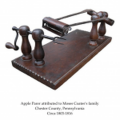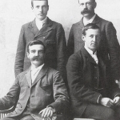Alfred D. Robinson
The California Begonia Society
February 26, 1942
Today is the anniversary of the death of the British-American horticulturist and founder of the California Begonia industry, Alfred D. Robinson.
Along with his wife Marion, Alfred’s passion was flowers.
In the early 1900s, after hearing a religious leader speak about a utopian community called Lomaland, Alfred and Marion moved to Point Loma. Yet, their fresh start in Point Loma, which included buying ten acres of land, was irreparably damaged when their young daughter Lenora died of a heart issue.
Losing Lenora devastated the Robinsons, and they left Point Loma and began building a new home in San Diego. As the gardens were getting established, their 15,000 square-foot mansion was being built - and that mansion was called Rosecroft.
The Rosecroft property became the home base for Alfred’s Gegonia breeding program. As Rosecroft’s high-quality Begonias went to nurseries and botanists around the country, Alfred solidified his reputation as a high-quality Begonia grower.
Now Alfred came up with the idea to use Lath houses for growing his begonias. If you need help picturing a Lath House, imagine a pergola with sides. Webster defines a Lath House as a structure of laths or slats spaced to reduce excessive sunlight while permitting air circulation. Lath Houses are fabulous for plants that need more shade and protection from strong winds.
In 1933, the LA Times ran a story called The Useful Lath House by Eva Dale, and in it, Eva described the Rosecroft Lath House.
“Lath offers the desired protection as well as effecting a substantial saving in water. By lathing the sides and part of the roof of a garden, a barren wind-swept space can be transformed into a thing of beauty affording shelter to man and plant alike.
This may be done on a grand scale, as at "Rosecroft" at Point Loma, where Alfred Robinson has about an acre under Lath, or at Whitehill, Redlands, where Clarence White has an acre and a half of sun protection; but it can also give a great deal of satisfaction when done in a very modest fashion.
Mr. Robinson is an authority on Begonias and Mr. White on Roses, but they both declare that these and many other plants do infinitely better in partial shade. Mr. White says that "besides the conservation of bloom and vigor and the transpiration of water, there is also a moderation of the extremes of heat and cold." He adds that "there is less frost, and better recovery when it does penetrate."
Walter Merrill, former president of the San Diego Rose Society, has varied the idea somewhat by using Bamboo instead of Lath... After a year and a half, he says he would not, for anything, return to full sun for his roses.”
An early Rosecroft pamphlet described their growing operation this way:
“Rosecroft is on Point Loma, the head of land that forms the Northwest boundary of the Bay of San Diego California, and…
enjoys the year-round mildness of climate coupled with a moist atmosphere… [which] permits the cultivation of the Begonia with a simple Lath protection.
In such a shelter, Rosecroft grows… the best exposition of this family in the world.
The so-called Tree Begonias attain a height of 24 ft and all sorts flourish.”
In 1907, Albert and Marion, along with the great Kate Sessions, formed the San Diego Floral Association, and Albert served as the first president. Two years later, the group started a little publication called California Garden… and it is still published today.
And it was the botanist Charles Plumier ("Ploo-me") named the Begonia in honor of a man he much admired: Michel Bégon ("ME-shell Bay-GO-n"), a French amateur botanist. Charles discovered the Begonia growing on the island of Santo Domingo.
Although they are beautiful, most Begonias have no scent. And if you’ve been growing Begonias in full sun, you’ll immediately understand why Albert grew his under a Lath House because they prefer part shade. In the wild, Begonias grow under filtered light.
The Begonia traditionally symbolizes caution or hesitation. I always found this curious until I researched the family name Bégon, which is rooted in Old French as a slang word for a person who stuttered. I thought it happened to be a meaningful coincidence - the meaning of caution or hesitation with a stutter.
You may be surprised to learn that the flowers and leaves of the Begonia are edible; some cultures around the world add begonias to salads.
Finally, the Begonia is the flower that produces the smallest seeds. Begonia seeds are so fine that they are often compared to dust. This is why, if you grow Begonias from seed, they are often pelleted.
In 1932, the California Begonia Society was formed, and in a few short years, they started a little bulletin called The Begonian. In 1935, Alfred Robinson suggested the group broaden their reach - and the American Begonia Society was born.
This post was featured onThe Daily Gardener podcast:
helping gardeners find their roots,
one story at a time






